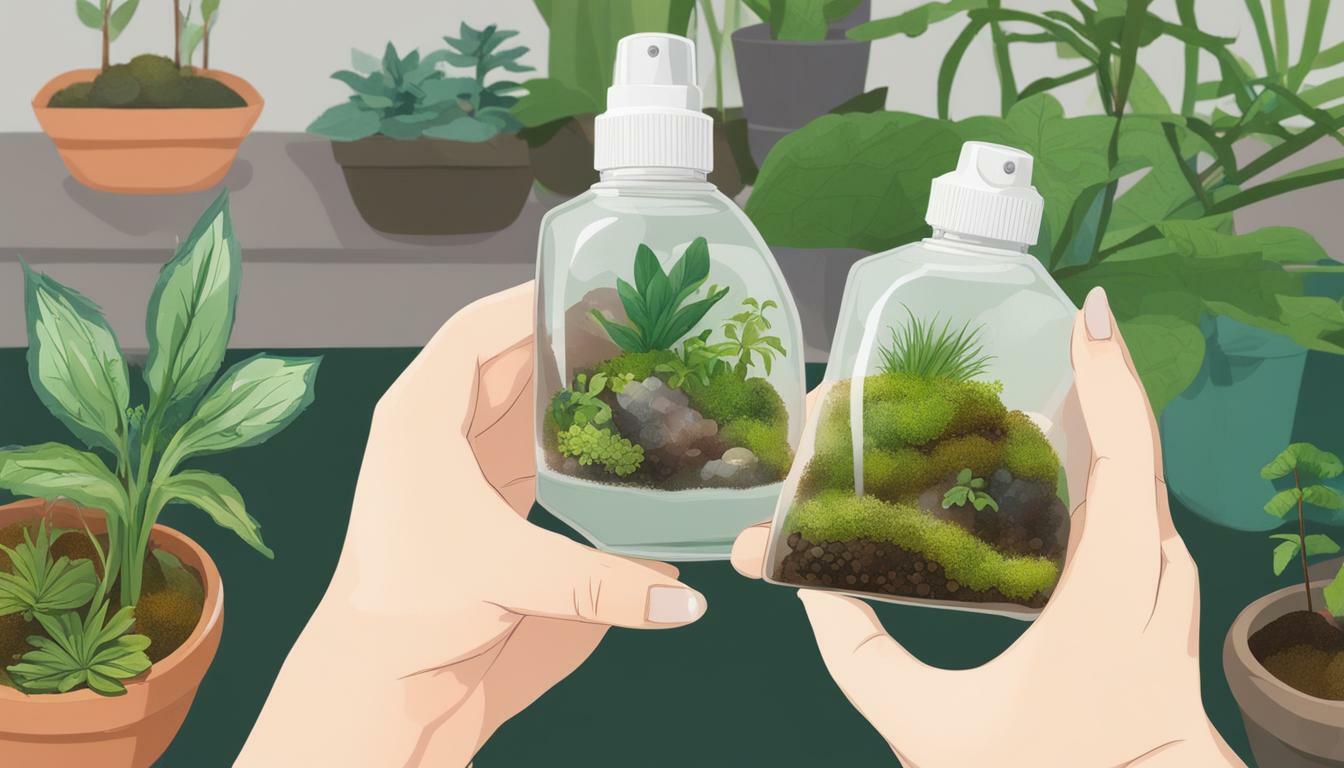Terrariums require careful attention and proper disease management to ensure the longevity and health of their ecosystem. These self-sustaining environments need basic care and maintenance to thrive. From lighting and temperature to moisture control and regular maintenance, every aspect plays a vital role in terrarium health.
Proper lighting is crucial for the well-being of terrarium plants. Placing the terrarium in a well-lit area with indirect sunlight is ideal. A temperature range of 19-21C provides optimal conditions for the plants to grow. Condensation can be managed by controlling moisture levels and ensuring proper ventilation.
Observation is key when it comes to watering terrariums. Watering should be done based on the plants’ needs and the moisture levels observed. It is important to avoid overwatering or underwatering, as both can lead to diseases and plant stress.
Mold and fungus can pose a threat to terrarium health. Promptly addressing any signs of mold or fungus is crucial. Regular pruning of plants and adjusting lighting levels are necessary to maintain their overall health and prevent disease outbreaks.
Terrariums can attract pests such as fungus gnats. Removing soil from plant roots can help reduce their presence. Additionally, introducing beneficial insects or using natural insecticides can aid in pest control.
Regular maintenance is essential to keep terrariums in optimal condition. Cleaning the terrarium, replacing dead plants, and managing green algae growth are necessary tasks for maintaining a healthy environment.
To summarize, terrariums require careful attention and proper disease management for their longevity and health. By following recommended practices and being proactive in maintaining terrarium health, you can ensure the success of your own miniature ecosystem.
Key Takeaways:
- Proper lighting, temperature, and moisture control are essential for terrarium health.
- Observation and watering based on moisture levels are important to prevent overwatering or underwatering.
- Promptly address signs of mold, fungus, and pests to prevent disease outbreaks.
- Regular maintenance tasks such as cleaning, plant replacement, and algae control are crucial for terrarium health.
- Following recommended practices and being proactive in terrarium care will ensure the longevity and success of your miniature ecosystem.
By understanding the basic principles of terrarium care, you can effectively prevent and manage common diseases that may impact your terrarium. Terrariums are self-sustaining ecosystems that require proper lighting, temperature control, and moisture management to thrive. Placing your terrarium in a well-lit area with indirect sunlight is essential for the health of the plants.
Temperature regulation is crucial as most terrarium plants prefer a temperature range of 19-21°C. It is important to monitor and maintain the correct temperature to prevent stress or damage to the plants. Additionally, managing condensation by controlling moisture levels is vital to prevent the growth of mold or fungus in your terrarium.
Observation is key when it comes to preventing terrarium diseases. Inspect your terrarium regularly for any signs of discoloration, wilting, or unusual growth patterns. Early detection allows for prompt action and minimizes the risk of diseases spreading within the terrarium. Watering should be done based on observation, ensuring that you provide the appropriate amount of water without overwatering or underwatering the plants.
Pruning and making necessary lighting adjustments are integral parts of terrarium care. Regularly prune your plants to maintain their shape and health, removing any dead or decaying parts. As for lighting, adjust the intensity and duration to ensure your plants receive the optimal amount of light. By following these basic care practices, you can create an environment that promotes the well-being of your terrarium plants and prevents common diseases from taking hold.
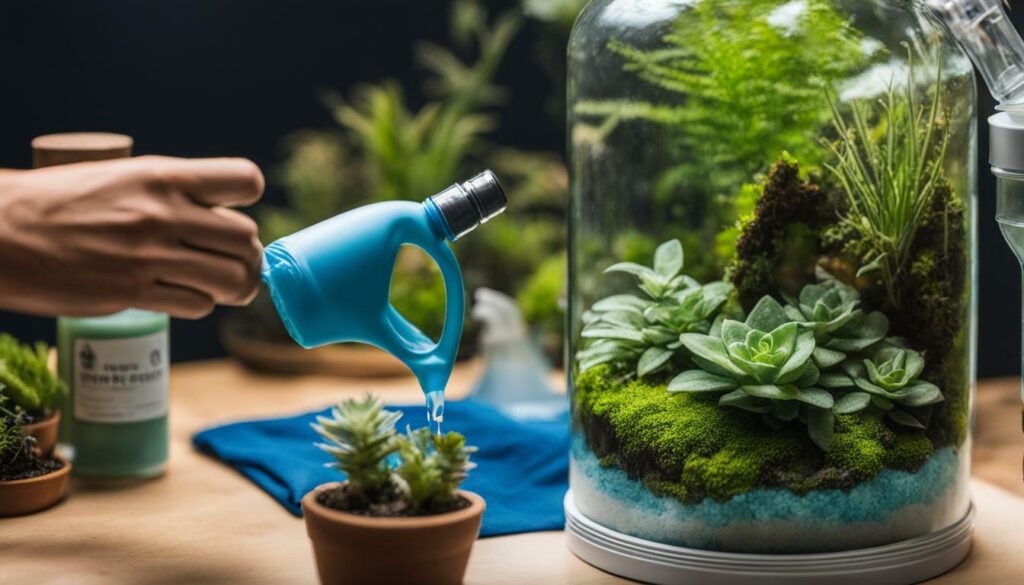
| Common Terrarium Diseases | Prevention and Management |
|---|---|
| 1. Fungal Infections | Ensure proper moisture control and ventilation. Remove affected parts and treat with a natural fungicide if necessary. |
| 2. Root Rot | Avoid overwatering and make sure the terrarium has good drainage. Remove affected plants and adjust watering practices. |
| 3. Pest Infestation | Monitor for signs of pests such as fungus gnats. Remove soil around plant roots to reduce pests’ habitat. Use natural insecticides or introduce beneficial insects to control the infestation. |
Remember that prevention is always better than cure when it comes to terrarium diseases. By taking the time to understand the basics of terrarium care and implementing the necessary measures, you can enjoy a healthy and thriving terrarium for years to come.
Creating the Optimal Terrarium Environment
By implementing the right terrarium care practices, you can create an optimal environment that safeguards against diseases and ensures the health of your terrarium. Maintaining proper moisture levels is crucial in preventing the growth of mold, fungus, and pests. Regular pruning and lighting adjustments are also necessary for the well-being of terrarium plants.
In order to manage moisture effectively, it is essential to strike a balance between watering and controlling condensation. Watering should be done based on observation and the specific needs of the plants within the terrarium. Overwatering can lead to root rot and other diseases, while underwatering can cause plants to wilt and die.
Proper pruning is another important aspect of terrarium care. Pruning helps maintain the overall health and appearance of the plants by removing dead or overgrown parts. It also promotes better airflow within the terrarium, reducing the risk of fungal and bacterial infections.
Adjusting the lighting is crucial for the well-being of your terrarium plants. Different plants have varying light requirements, so it is important to provide the appropriate amount of light for each species. By monitoring the growth and coloration of the plants, you can determine if they are receiving adequate light. If necessary, you can adjust the position of the terrarium or use artificial grow lights to supplement natural light.
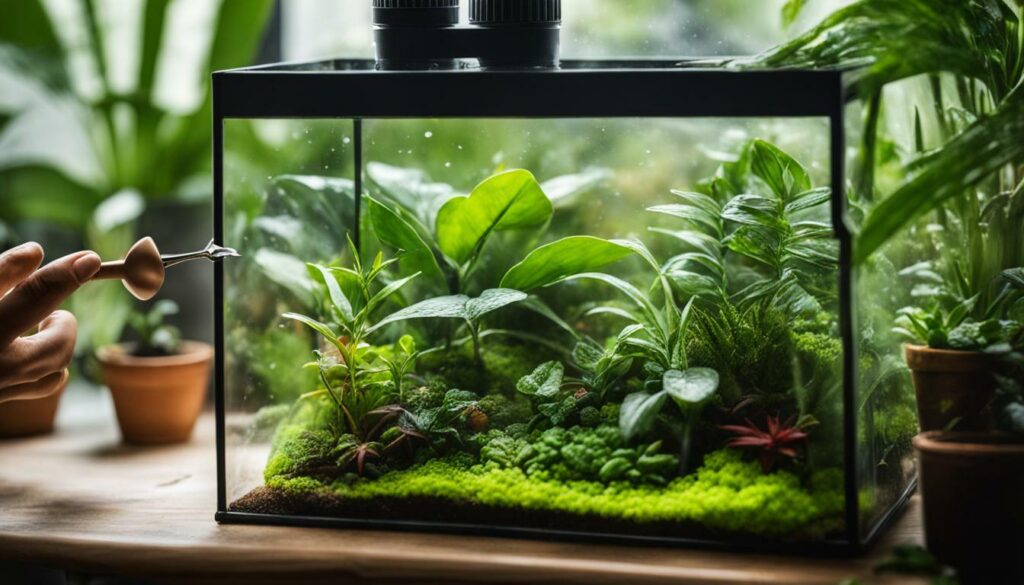
| Terrarium Care Tips | Managing Terrarium Health |
|---|---|
| Monitor moisture levels regularly and adjust watering accordingly. | Regularly prune plants to remove dead or overgrown parts. |
| Control condensation by providing proper airflow and managing humidity levels. | Monitor plant growth and coloration to ensure they are receiving adequate light. |
| Inspect regularly for signs of mold, fungus, or pests and take appropriate action. | Adjust the position of the terrarium or use artificial grow lights if necessary. |
Remember, maintaining an optimal terrarium environment requires consistent care and attention. By implementing these terrarium care tips and managing the health of your terrarium, you can enjoy a thriving ecosystem that brings beauty and tranquility to your space.
Observing and Monitoring Your Terrarium
Regular observation and monitoring are crucial in maintaining the health and well-being of your terrarium ecosystem. By keeping a close eye on your terrarium, you can quickly spot any signs of disease or imbalance and take appropriate action. Here are some key tips for effective observation and monitoring:
- Check for discoloration or wilting: Thoroughly inspect the leaves and stems of your plants for any changes in color or signs of wilting. These can be early indicators of disease or inadequate environmental conditions.
- Look out for unusual growth patterns: Keep an eye on the growth patterns of your plants. If you notice any abnormal or stunted growth, it may indicate nutrient deficiencies or other issues.
- Monitor moisture levels: Regularly assess the moisture levels in your terrarium. Excessive condensation or dryness can lead to problems, such as mold or dehydration. Adjust watering accordingly based on the specific needs of your plants.
- Keep track of pests: Watch for any signs of pest infestation, such as tiny insects or damage to leaves. Common pests in terrariums include fungus gnats. If you spot any pests, take immediate steps to address the issue to prevent further damage.
Remember to document your observations and keep a record of any changes or issues you notice. This will help you track the progress of your terrarium and make informed decisions about necessary adjustments or treatments.
By being proactive and attentive in your terrarium observation and monitoring, you can ensure the continued health and vitality of your mini ecosystem.
Key Observations Table
| Observation | Action |
|---|---|
| Discoloration or wilting | Investigate possible causes, such as disease, inadequate lighting, or improper watering. Take appropriate measures, such as adjusting environmental conditions or treating diseases. |
| Unusual growth patterns | Assess nutrient levels and adjust fertilization if necessary. Consider pruning or repotting if root-bound. |
| Moisture levels | Monitor condensation and adjust watering frequency. Ensure proper drainage to prevent waterlogged soil. |
| Pest infestation | Identify the pest and use appropriate remedies, such as beneficial insects or natural insecticides. Remove affected plants if necessary. |
Dealing with Terrarium Diseases
When facing terrarium diseases, taking immediate steps can prevent further damage to your terrarium’s ecosystem. Disease prevention is essential to maintaining the health and longevity of your terrarium. By following proper care practices and being proactive in identifying and addressing issues, you can ensure a thriving environment for your plants.
One of the most important aspects of disease management is observation. Regularly inspect your terrarium for signs of disease, such as discoloration, wilting, or unusual growth patterns. Early detection allows for early intervention, increasing the chances of successful treatment. Additionally, monitoring the water requirements of your terrarium is crucial. Overwatering or underwatering can stress plants and create a favorable environment for disease development. Adjust watering based on your observations and the specific needs of your plants.
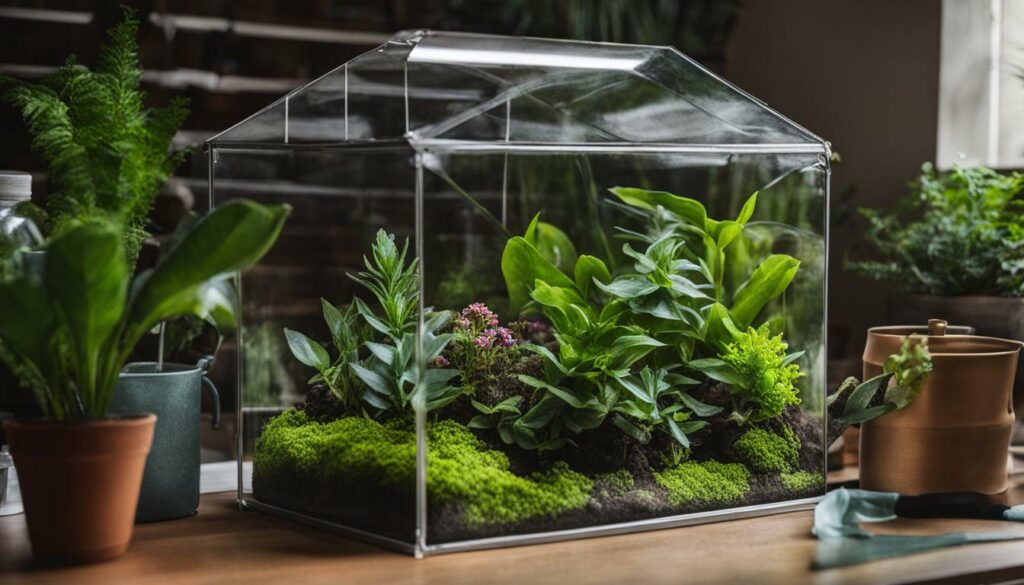
Common terrarium diseases can be caused by various factors, including excessive moisture, poor air circulation, and improper lighting. To prevent diseases, it is important to maintain a well-balanced terrarium environment. This includes managing condensation by controlling moisture levels and ensuring adequate airflow within the terrarium. Regular pruning can also help promote plant health by removing dead or decaying plant material that can attract pests and diseases.
When treating terrarium diseases, it is advisable to start with natural remedies. Remove affected plant parts promptly to prevent the spread of disease. Adjust environmental conditions, such as lighting and temperature, to create an unfavorable environment for disease development. Natural insecticides, such as neem oil, can be used to control pests like fungus gnats. Taking these steps in a timely manner can help restore the health and balance of your terrarium.
| Preventive Measures | Treatment |
|---|---|
|
|
Managing Pests in Your Terrarium
Preventing and managing pests is an essential aspect of terrarium care disease management. While terrariums create a self-sustaining ecosystem, they can still attract unwanted pests like fungus gnats. These pests can harm your plants and disrupt the overall balance of the terrarium. To keep your terrarium healthy and pest-free, here are some effective strategies:
- Remove soil from plant roots: Fungus gnats are attracted to moist soil. By removing the top layer of soil in your terrarium, you can eliminate their breeding grounds and reduce their presence.
- Use natural insecticides: If you notice an infestation, consider using natural insecticides such as neem oil or insecticidal soap. These solutions are effective in controlling pests while being safe for your plants and the terrarium ecosystem.
- Introduce beneficial insects: Some beneficial insects like predatory mites or nematodes can help control pest populations in your terrarium. These insects can prey on pests and maintain a harmonious environment without causing harm to your plants.
It is also important to maintain a clean terrarium environment to discourage pest infestations. Regularly remove fallen leaves or debris, as they can attract pests. Keep an eye out for signs of pests, such as unusual plant damage or the presence of gnats. Taking prompt action when pests are detected will prevent them from spreading and causing further damage to your terrarium.
Table: Common Pests in Terrariums
| Pest | Description | Prevention |
|---|---|---|
| Fungus Gnats | Small flying insects that lay eggs in moist soil | Remove top layer of soil, use natural insecticides, introduce beneficial insects |
| Spider Mites | Tiny mites that suck sap from plant leaves, causing wilting and discoloration | Regularly mist leaves to increase humidity, remove infested leaves, use natural insecticides |
| Mealybugs | Small white insects that feed on plants, leaving behind a cotton-like residue | Remove infested leaves, use natural insecticides, introduce beneficial insects |
By following these strategies and maintaining a vigilant approach, you can effectively manage pests in your terrarium and ensure the health and longevity of your plants. Regular observation and prompt action are key to preventing and controlling pests, allowing your terrarium to thrive as a self-sustaining ecosystem.
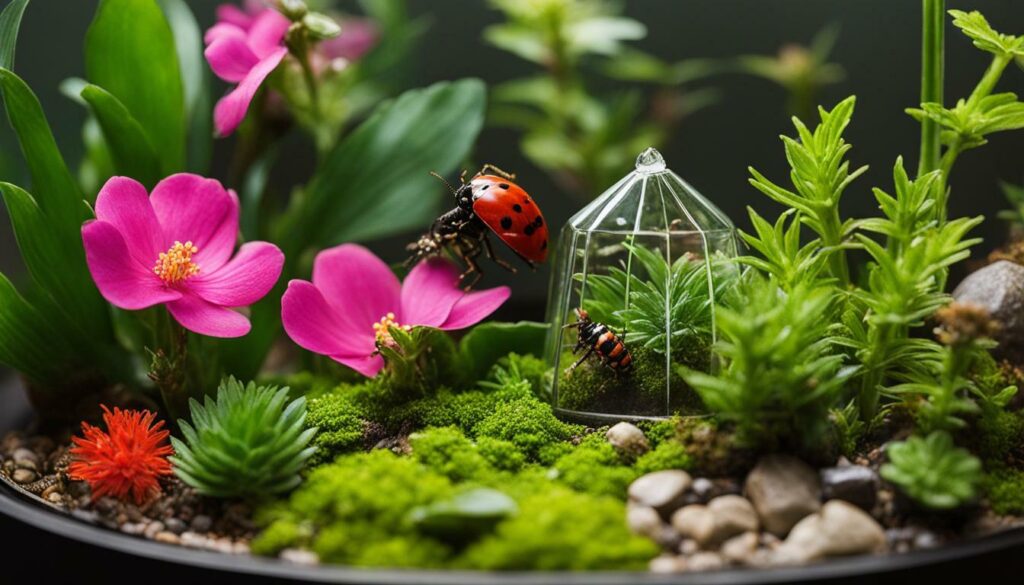
Regular maintenance is essential to keep your terrarium healthy and thriving. Terrariums are self-sustaining ecosystems, but they still require basic care and attention to ensure their longevity. By following proper maintenance practices, you can prevent issues such as mold, fungus, and pest infestations, and keep your terrarium looking beautiful.
One important aspect of terrarium maintenance is ensuring proper lighting and temperature. Placing your terrarium in a well-lit area with indirect sunlight is crucial for the photosynthesis process of the plants. Maintaining a temperature of around 19-21°C creates an optimal environment for plant growth and prevents stress on the ecosystem.
Controlling moisture levels and managing condensation are also key factors in terrarium care. Overwatering can lead to root rot and the growth of mold or fungus, while underwatering can cause dehydration and plant wilting. Therefore, it’s important to water your terrarium based on observation. Check the moisture levels of the soil and adjust the watering frequency accordingly.
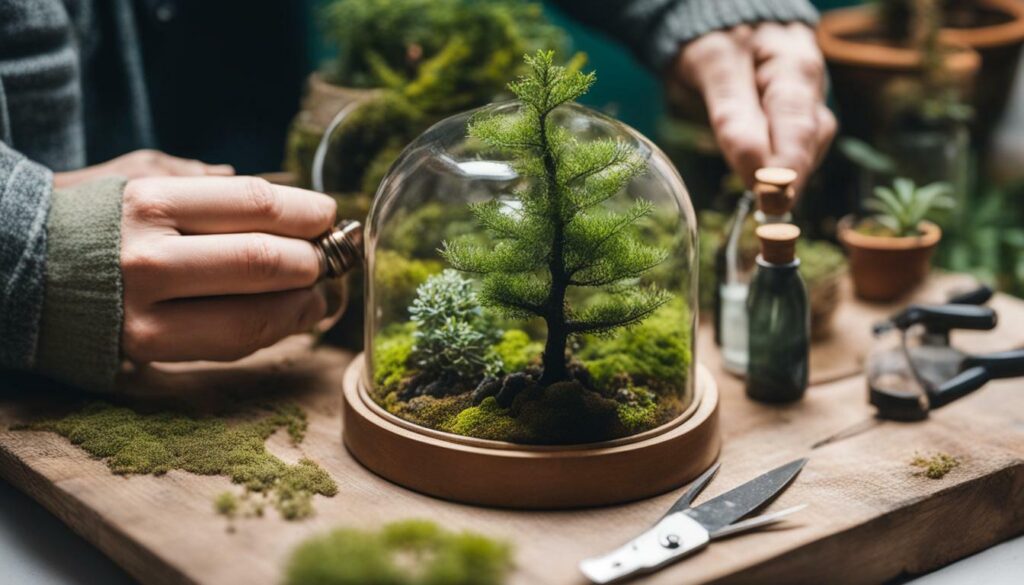
Regular pruning is necessary to maintain the health and shape of your terrarium plants. Trimming off dead or yellowing leaves will not only improve the overall aesthetics of your terrarium but also prevent the spread of diseases. Additionally, if you notice that certain plants are not thriving in your terrarium, consider adjusting the lighting. Some plants may require more sunlight, while others prefer shade. It’s important to find the right balance to ensure the well-being of all the plants in your terrarium.
Cleaning and maintaining a clean terrarium environment is vital for preventing the growth of algae and the spread of pests. Remove any dead or decaying plant material to avoid attracting insects or pests. If you notice any signs of pest infestations, such as fungus gnats, you can reduce their presence by removing soil from plant roots and introducing natural insecticides or beneficial insects that prey on pests.
By following these regular maintenance practices, you can create a healthy and thriving terrarium that will bring beauty and tranquility to your home or office. Remember to observe your terrarium regularly and take prompt action if you notice any signs of disease or pest infestations. With proper care and attention, your terrarium will continue to flourish for years to come.
Troubleshooting Common Terrarium Issues
Troubleshooting common terrarium issues is key to maintaining a thriving terrarium environment. Despite your best efforts to create the perfect conditions, you may encounter some challenges along the way. Here are some common issues that terrarium owners face and solutions to help you overcome them.
1. Plant Overcrowding
One issue that can arise in a terrarium is plant overcrowding. As plants grow and spread, they may start to compete for space, light, and nutrients. This can lead to stunted growth, yellowing leaves, and even plant death. To address this issue, regularly assess the growth of your terrarium plants and remove any overcrowded ones. Prune back excessive growth and replant in a separate container if necessary.
2. Excessive Condensation
Condensation is a normal occurrence in terrariums, but excessive moisture can lead to problems. It can create a breeding ground for mold and fungus, which can harm your plants. To reduce excessive condensation, provide proper airflow by partially opening the terrarium lid. You can also use a small fan or dehumidifier to control moisture levels. If mold or fungus does appear, remove affected plant parts and adjust the terrarium’s conditions.
3. Unusual Odors
Unpleasant odors in your terrarium can indicate an imbalance in the ecosystem. This could be due to decaying plant matter or the presence of harmful bacteria. Regularly check your terrarium for any dead or decaying plant material and remove it promptly. Additionally, ensure proper ventilation and avoid overwatering, as these can contribute to odor issues.
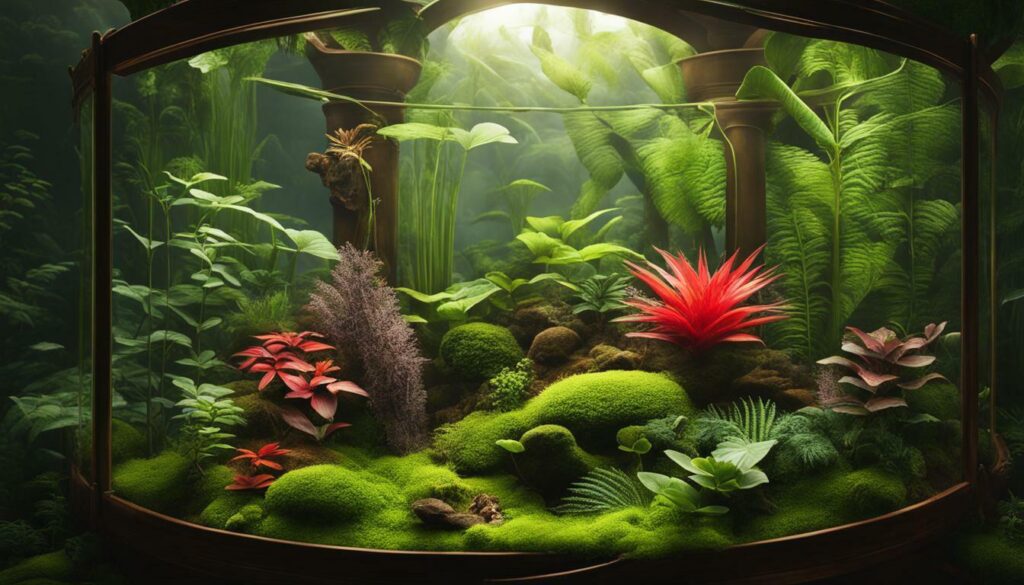
The right soil composition is essential for the health of your terrarium plants. If you notice signs of nutrient deficiency or excess, such as yellowing leaves or stunted growth, it may indicate a soil imbalance. Test the pH levels of your terrarium soil and adjust accordingly. You can add organic matter or specific fertilizers to provide the necessary nutrients for your plants.
By addressing these common terrarium issues promptly, you can ensure the long-term health and success of your terrarium. Remember to regularly observe and monitor your terrarium, making adjustments as needed to create an optimal environment for your plants to thrive.
What Are the Best Strategies for Managing Terrarium Care Diseases?
When it comes to terrarium care, it’s crucial to have effective terrarium disease prevention strategies in place. Regularly inspect plants for any signs of disease or pests, and promptly remove any affected foliage. Proper ventilation and good hygiene practices can also help keep terrariums healthy and thriving.
Conclusion
By implementing effective terrarium care disease management strategies, you can enjoy a vibrant and healthy terrarium for years to come. Terrariums are self-sustaining environments that require basic care and attention during the settling-in period. It is crucial to place your terrarium in a well-lit area with indirect sunlight to ensure adequate photosynthesis for plant health. Additionally, maintaining a temperature of around 19-21C is essential for the optimal growth and overall well-being of your terrarium.
One of the key aspects of terrarium care is managing condensation by controlling moisture levels. Regular observation is necessary to determine the watering needs of your terrarium. Remember to water your plants based on observation, taking into account signs of wilting or excessive dryness. To prevent the growth of mold or fungus, promptly address any signs of discoloration or unusual growth patterns in your terrarium. Maintaining proper air circulation and humidity levels will also contribute to a healthy terrarium ecosystem.
Pests can sometimes pose a challenge to terrarium health. Fungus gnats, for example, can be reduced by removing soil from plant roots and using natural insecticides. Pruning and making lighting adjustments may also be necessary to ensure the optimal growth of your terrarium plants. Regular maintenance is vital to the longevity and health of your terrarium. This includes cleaning the terrarium, replacing dead plants, and managing green algae growth.
It is important to follow proper establishment and maintenance practices to ensure the longevity and health of your terrarium. With a little attention and care, your terrarium can thrive and provide a beautiful and natural display in your home or office.
FAQ
What are terrariums?
Terrariums are self-sustaining environments that require basic care and attention during the settling-in period.
Where should I place my terrarium?
Terrariums should be placed in a well-lit area with indirect sunlight.
What temperature is ideal for terrariums?
Terrariums thrive in temperatures around 19-21C.
How do I manage condensation in my terrarium?
Condensation can be managed by controlling moisture levels.
How often should I water my terrarium?
Watering should be done based on observation, avoiding overwatering or underwatering.
How do I deal with mold or fungus in my terrarium?
Signs of mold or fungus should be dealt with promptly to prevent the spread of diseases.
Can terrariums attract pests?
Yes, terrariums may attract pests like fungus gnats, which can be reduced by removing soil from plant roots.
Do I need to prune my terrarium plants?
Pruning may be necessary for plant health and to prevent overcrowding.
How do I maintain my terrarium?
Regular maintenance such as cleaning, replacing dead plants, and managing green algae growth is important.
What should I do if my terrarium has issues?
Troubleshoot common terrarium issues, such as plant overcrowding or excessive condensation, to maintain a healthy terrarium ecosystem.

